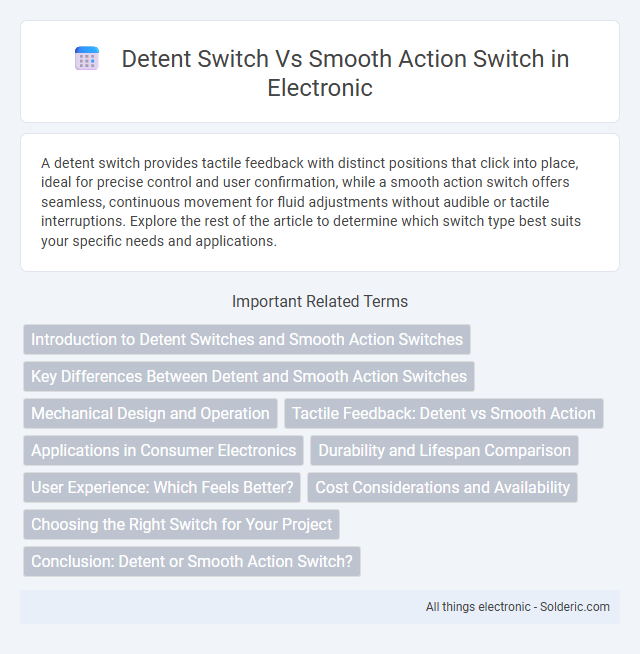A detent switch provides tactile feedback with distinct positions that click into place, ideal for precise control and user confirmation, while a smooth action switch offers seamless, continuous movement for fluid adjustments without audible or tactile interruptions. Explore the rest of the article to determine which switch type best suits your specific needs and applications.
Comparison Table
| Feature | Detent Switch | Smooth Action Switch |
|---|---|---|
| Operation Feel | Distinct click or "detent" feedback | Continuous, smooth movement without tactile stops |
| Use Case | Settings requiring precise position indication | Applications needing fluid control without interruptions |
| Position Feedback | Provides physical feedback at each switch position | Lacks discrete tactile feedback, movement is seamless |
| Typical Applications | Rotary controls, volume knobs, gear selectors | Light dimmers, sliders, continuous adjustment controls |
| Durability | High due to robust mechanical detents | Varies, often less mechanical wear due to smooth action |
| Installation Complexity | Moderate, requires alignment for detent positions | Simple, fewer mechanical constraints |
Introduction to Detent Switches and Smooth Action Switches
Detent switches feature a tactile feedback mechanism with defined click positions, providing precise control during operation. Smooth action switches offer seamless, noise-free activation without distinct stops, ideal for applications requiring fluid motion. Understanding these differences helps you select the appropriate switch type for specific device responsiveness and user experience needs.
Key Differences Between Detent and Smooth Action Switches
Detent switches provide tactile feedback with distinct physical stops at specific positions, enhancing user precision and control in applications like volume knobs or rotary encoders. Smooth action switches offer continuous, frictionless movement without tactile clicks, ideal for settings requiring seamless adjustments such as dimmer switches or audio controls. The key difference lies in detent switches delivering incremental, repeatable steps, while smooth action switches enable fluid, uninterrupted motion.
Mechanical Design and Operation
Detent switches feature a mechanical design with predefined notches that create tactile feedback and distinct positions during operation, enhancing precision and user control. Smooth action switches utilize a continuous, friction-based mechanism without distinct stops, offering fluid motion ideal for applications that require subtle adjustments. The choice between these switches depends on whether tactile feedback or seamless movement is prioritized in the mechanical design and user interaction.
Tactile Feedback: Detent vs Smooth Action
Detent switches provide distinct tactile feedback through noticeable clicks or bumps at specific points, enhancing user awareness of actuation and position. Smooth action switches offer a consistent, fluid motion without tactile interruptions, resulting in less precise feedback but a more seamless operation. The choice between detent and smooth action depends on the need for tactile cues versus uninterrupted motion during use.
Applications in Consumer Electronics
Detent switches provide tactile feedback with distinct click sensations, making them ideal for consumer electronics like volume controls, gaming peripherals, and cameras where precise user input is crucial. Smooth action switches offer fluid, uninterrupted movement suited for touch-sensitive devices such as smartphones, tablets, and remote controls that prioritize seamless interaction. Your choice between detent and smooth action switches depends on whether you value incremental feedback or continuous control in your electronic applications.
Durability and Lifespan Comparison
Detent switches offer enhanced durability due to their mechanical design, featuring predefined tactile feedback points that reduce wear from continuous motion, leading to a longer lifespan in heavy-use applications. Smooth action switches provide a fluid, continuous movement but may experience faster wear and reduced longevity since they lack the tactile detents that help distribute mechanical stress. Your choice influences device reliability, with detent switches typically preferred in environments demanding durability and extended operational life.
User Experience: Which Feels Better?
Detent switches provide tactile feedback with distinct clicks, enhancing user confidence and precision during operation, making them ideal for applications requiring deliberate input. Smooth action switches offer seamless and quiet operation, delivering a fluid user experience preferred in environments needing uninterrupted or subtle control. Your choice depends on whether you prioritize tactile responsiveness or silent, effortless activation for the best user interaction.
Cost Considerations and Availability
Detent switches typically offer lower cost options due to their simpler mechanical design and widespread availability across various suppliers, making them budget-friendly for large-scale projects. Smooth action switches often come at a higher price point, reflecting their more refined tactile feedback and limited availability, especially in specialized or high-quality models. Your choice between these switches should balance cost efficiency with the desired user experience and the availability of components from trusted manufacturers.
Choosing the Right Switch for Your Project
Detent switches provide tactile feedback with defined positions, making them ideal for applications requiring precise control and confirmation of input, such as volume knobs or gaming controllers. Smooth action switches offer seamless, frictionless movement suitable for fluid adjustments and continuous control, often used in audio mixing or dimmer controls. Your choice depends on whether your project prioritizes discrete feedback or uninterrupted motion for optimal user experience.
Conclusion: Detent or Smooth Action Switch?
Detent switches provide tactile feedback with distinct click positions, ideal for applications requiring precise control and user confirmation of settings. Smooth action switches offer seamless, continuous motion without tactile stops, favoring scenarios where fluid adjustment or silent operation is essential. Choosing between detent and smooth action switches depends on whether tactile feedback or uninterrupted control is prioritized in the device design.
Detent switch vs Smooth action switch Infographic

 solderic.com
solderic.com